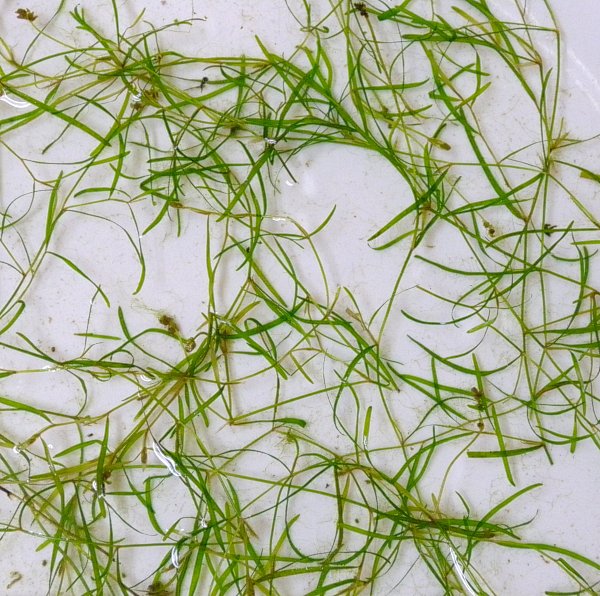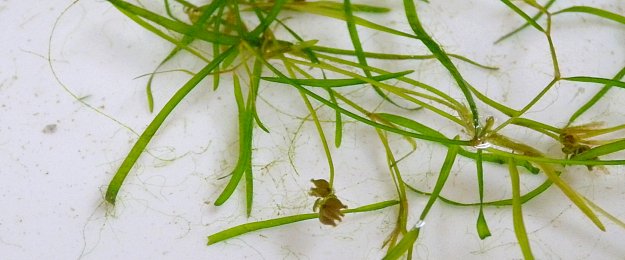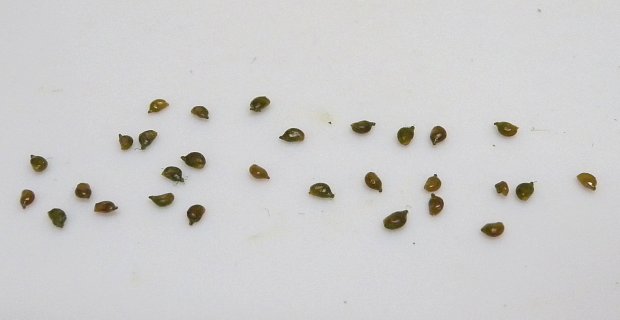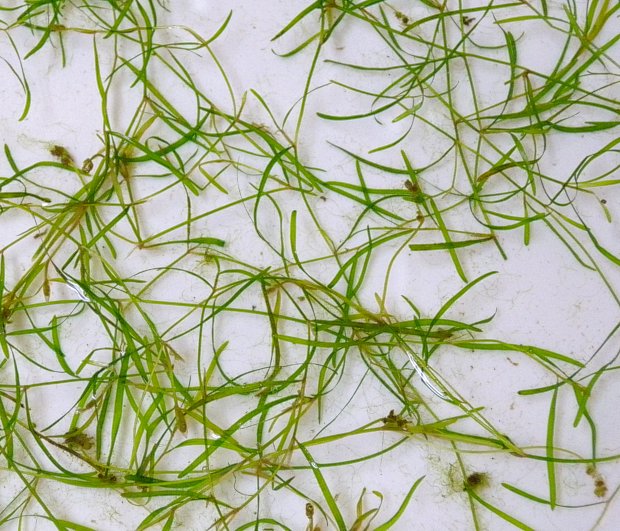
These floral spikes are 3-10 mm. long and 3-4 mm. across, consisting of 1-4 interrupted whorls of flowers. Each flower is about 2 mm. across, consisting of 4 green to greenish brown sepals (or sepaloid connectives), 4 stamens, and 4 pistils. The sepals are clawed (contract abruptly) at their bases. The peduncles are 12-52 mm. (½–2") long, narrowly terete to slightly flattened, pale green, and glabrous; they are either straight or curve upward toward the water surface. The blooming period occurs during the summer or early fall, lasting 2-4 weeks for a colony of plants. The flowers are cross-pollinated primarily by the wind and, to a lesser extent, by water currents. Afterward, fertile flowers are replaced by achenes that are initially green, but they later become brown with maturity. Individual achenes (while still fresh) are 1.5–2.5 mm. in length, 1.0-2.0 mm. across, and somewhat flattened; they are somewhat obovoid (where one edge is flat, while the other edge is convex) with short stout beaks at their apices. The sides of fresh achenes are convex, while the sides of dried-out achenes are flat to slightly concave. These achenes lack significant keels. The root system is fibrous. This plant reproduces vegetatively by the breakage of leafy stems that can form roots in the mud. It also reseeds itself. Sometimes colonies of plants are formed at favorable sites.

Cultivation: The preference is full or partial sun, clear shallow water that is relatively warm, and a muddy or silty bottom. The water should be stagnant or slow-moving. This pondweed can establish itself in more shallow water than many other pondweeds. It sometimes spreads aggressively. To discourage excessive growth of filamentous algae, which can smother this plant, the water should not contain excessive amounts of nitrogen, phosphorus, or other nutrients from fertilizer run-off.
Range & Habitat: Slender Pondweed (Potamogeton pusillus) is relatively common in most areas of Illinois, where it is native (see Distribution Map). This pondweed is widely distributed in North American, and it also occurs in Eurasia. Habitats include sheltered areas of lakes, ponds, slow-moving creeks, drainage canals, and deep ditches. Slender Pondweed can be found in both disturbed and higher quality wetlands where there are bodies of standing or slow-moving water.

Faunal Associations: The larvae of some shore flies (Ephydridae), including Hydrellia ascita and Hydrellia bilobifera, feed on the submerged leaves of this pondweed, as do the larvae of Parapoynx allionealis (Watermilfoil Leafcutter Moth). Larvae of the aquatic beetles Neohaemonia flagellata, Neohaemonia melsheimeri, and Neohaemonia nigricornis feed on the submerged stems and roots of various pondweeds (Potamogeton spp.); see the Insect Table for a more complete list of insect feeders. Because of its soft fine foliage and relative abundance, Slender Pondweed is one of the more important sources of food for vertebrate animals among the various pondweeds. Both the seeds and foliage are eaten by many ducks, geese, swans, and other birds (see Bird Table). Submerged pondweeds are also eaten by carp and other kinds of fish (see Forbes, 1888), and they are eaten by such turtles as Chelydra serpentina (Snapping Turtle), Chrysemys picta (Painted Turtle), Emydoidea blandingii (Blanding's Turtle), Graptemys ouachitensis (Ouachita Map Turtle), Graptemys pseudogeographica (False Map Turtle), Sternotherus odoratus (Musk Turtle), and Trachemys scripta (Slider); see Lagler (1943) and Ernest et al. (1994). Muskrats also feed on these plants (Hamerstrom & Blake, 1939; Martin et al., 1951/1961). Because Slender Pondweed often forms dense mats of leafy stems, it provides good cover for minnows, aquatic insects, and other aquatic organisms.
Photographic Location: The photographed plants were taken from a slow-moving stream at Meadowbrook Park in Urbana, Illinois.

Comments: In Illinois, there are two common species of pondweed with grass-like leaves that occupy similar habitats: Potamogeton foliosus (Leafy Pondweed) and Potamogeton pusillus (Slender Pondweed). Unless the flowering spikes or achenes are present, it is very difficult to distinguish these two species. At the achene-bearing stage, the floral spikes of Leafy Pondweed are more compact than those of Slender Pondweed. In addition, the peduncles of Leafy Pondweed are more short (less than 50 mm. in length) and more stout than those of Slender Pondweed. The achenes of these two species are also different in appearance: the achenes of Leafy Pondweed have prominent crested keels, while the achenes of Slender Pondweed lack significant keels. Because there is some variability in the characteristics of Slender Pondweed across its range, 2 different subspecies have been described: the typical subspecies (as described here) and ssp. tenuissimus. The latter subspecies differs by having stipules with inrolled margins that are not joined together (therefore, they are not truly tubular), its floral spikes are more compact and continuuous at the achene-bearing stage, and the sides of its dried achenes are convex, rather than flat or concave. Sometimes Potamogeton pusillus tenuissimus is classified as a distinct species, Potamogeton berchtoldii (Berchtold's Pondweed). In Illinois, this latter pondweed has been found in the NE section of the state, although it has not been collected since the 19th century. Even within the typical subspecies of Slender Pondweed, Potamogeton pusillus pusillus, there is significant variation in how widely separated the whorls of flowers are on the spikes. The floral spikes of this subspecies in Illinois tend to be less interrupted. Another common name of this subspecies is Small Pondweed.